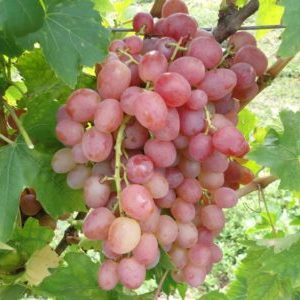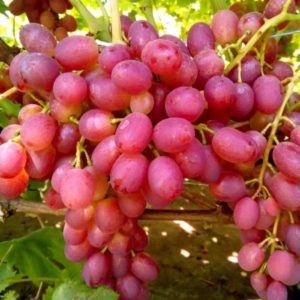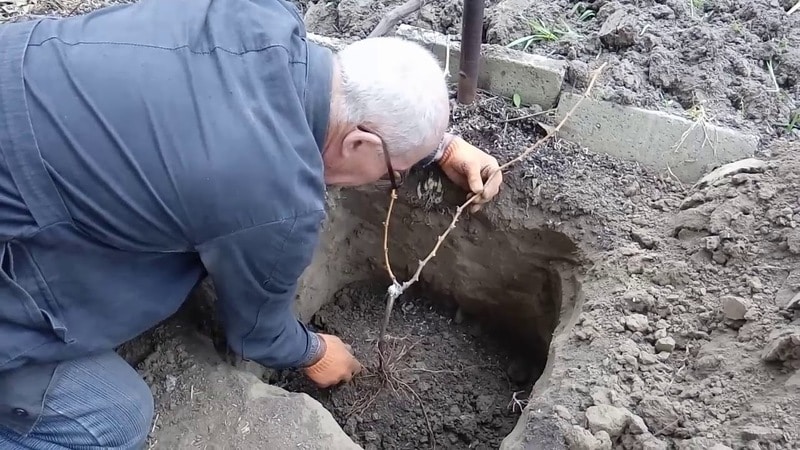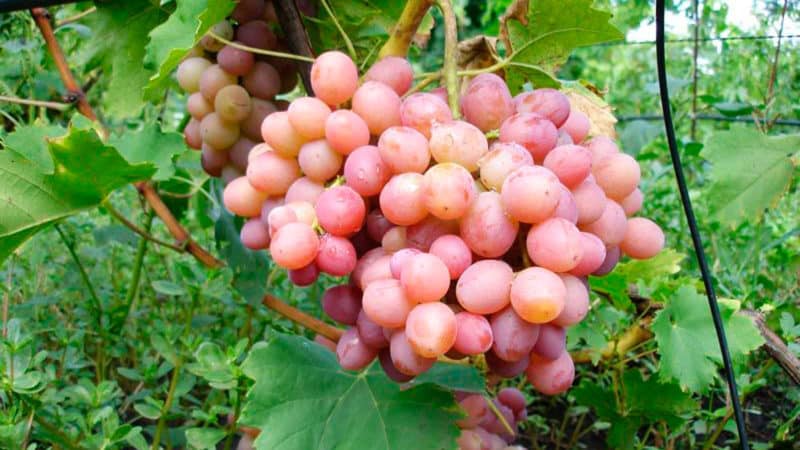Features of growing Libya grapes
Libya is a grape of Ukrainian selection, ideal for fresh consumption. The harvest ripens early, producing sweet, large berries with thin pink or golden-pink skin and a nutmeg aroma already at the end of July. The grapes are not resistant to fungal diseases and phylloxera, but with proper care and preventive treatments, such problems can be avoided.
Description of Libya grapes

Libya is a table grape variety bred by breeder V.V. Zagorulko. Despite its relatively recent appearance (1999), the culture has managed to gain recognition among winegrowers. The Ukrainian breeder transferred the copyright to the Crimean Research Institute of Viticulture and Winemaking “Magarach”.
In 2011, Libya was included in the State Register of Ukraine, and in 2014 it was allowed to be grown in the North Caucasus region (Rostov region, Ingushetia, Stavropol and Krasnodar territories, Dagestan, Republic of Adygea, Crimea, North Ossetia - Alania, Kabardino-Balkarian, Chechen) and entered into the State Register of the Russian Federation.
Zagorulko bred Libya based on the maternal form of the Flamingo variety, convenient for cross-pollination, with a female type of flowering, and the paternal form, the famous Arcadia variety. As a result, the world saw ultra-early large-fruited grapes with large pink berries and a pleasant aroma.
Characteristics
Livia ripens early, with a growing season of 100–110 days from bud break to harvest ripeness. The grapes are suitable for cultivation even in regions with cold climates. For ripening, a sum of active temperatures of 2100°C is sufficient. The crop begins to bear fruit 3 years after planting.
Bushes are distinguished by their high growth vigor, and those grown on their own roots are vigorous. Young shoots have light green crowns without pubescence. A solid first leaf of round shape is formed on the shoot, the subsequent ones are five-lobed, wide, medium-dissected, without pubescence. The side cuts on the sheet plate are open, with a sharp bottom and parallel sides. The petiole notch is open, lyre-shaped, the mouth is narrow, the bottom is rounded. The edges of the leaf are jagged, triangular, large, wide at the base. The color is green; in autumn the leaves turn yellow at the edges. The flowers are bisexual and do not require additional pollination. There is no tendency to peas.
The clusters are large, cylindrical-conical or shapeless, branched, loose in structure, from 25 cm long. Average weight - 0.8-1.2 kg. The berries are located freely and are not squeezed. The comb and stalk are long and light green in color. The berries are large, obtusely ovoid in shape, measuring 22x28 mm, weighing 10–12 g. The skin is thin, golden-pink or pink, cannot be felt when consumed, covered with a white coating. The color depends on the climatic conditions of the growing region and is less intense.
The flesh is dense, crispy and juicy at the same time. The taste is pleasant, the content of sugars and acids is balanced, the aroma of nutmeg is pronounced and persists for a month after harvest. The seeds are small, separated from the pulp, and there are 1–3 of them per berry.
Reference. Sugar content juice - 18.8 g/100 ml, acidity - 6.2 g/l.
Bunches of Livia grapes hang on the bush for a long time after ripening, maintaining freshness due to their loose structure. In dry weather, the berries do not crack, but in high humidity there is a risk of a similar problem.
Table grapes are suitable for fresh consumption, so it is important to provide protection against wasps. Libya appears on the market earlier than anyone else, has an attractive appearance and is in demand among consumers. However, the thin skin of the berries reduces the shelf life and the ability to transport goods over long distances. The bunches need careful collection and transportation.
Yield indicators are moderate, but with proper care the crop bears fruit consistently and abundantly. In favorable years, it is possible to collect about 25–30 kg of berries from one bush.
When testing the variety, the potential yield was assessed highly - 168 c/ha. Frost resistance average - up to -21°C. Growing as an uncovered crop is possible in regions with warm climates. The shoots ripen completely, but if there is excessive load on the bush, it is not enough. One-year-old ripened shoots are colored light brown. The number of fruitful shoots is 70–80%.
Growing
To maintain productivity and obtain high-quality bunches, it is important to adhere to the rules for choosing a place for planting and caring for the vineyard. Neglect of the crop leads to loss of harvest, weakening of the bushes and death of the vine in winter.
Landing rules

Livia's cuttings root without problems and are compatible with any rootstock. The crop is planted in two ways: seedlings or grafting.
In the first case, excellent results in growth are achieved. This method improves the taste of the berries. Upon landing Grafting onto a rootstock increases the fruiting of bushes and increases productivity.
Before planting, the roots are treated with a solution to stimulate root formation (“Kornevin”), the ends are cut off with pruning shears, dipped in liquid paraffin, then cooled in cold water. This allows you to retain moisture and strengthen the seedling’s resistance to external negative factors.
Landing rules:
- The hybrid prefers sunny areas, so the plants are planted so that the fence or walls of the house serve as protection from drafts and support.
- The ideal soil is black soil, but the crop adapts to any type of soil provided nutrients are added when planting and growing.
- In the southern regions, grapes are planted in spring or autumn, in the middle zone - in April.
- In the summer before planting, the area is dug up and a solution of chicken manure (1:15) is added.
- In autumn, dig a planting hole measuring 70x70 cm.
- A layer of drainage (broken brick or crushed stone) is placed at the bottom of the pit, and a thick pipe is installed for irrigation in the first few years. A layer of fertilized soil is poured on top, followed by soil without fertilizers.
- The roots of the seedling are straightened; they should be in clean soil. Add a layer of earth on top, without deepening the root collar, and mulch the tree trunk circle.
Features of care
Hybrid Libya grows best in moist soils. Watering is carried out 2 times a season: before and after flowering. During dry periods, the frequency of irrigation is increased, but overflows are not allowed - this leads to the development of fungal diseases. Assessing the condition of the foliage will tell you when to water the plant. Yellowing, dry and brown spots on the leaves are signs of moisture deficiency. Dark green leaves should alert you - this is the first symptom of chlorosis.
The soil under the bushes is mulched with straw, humus, hay or peat. This helps protect the grapes from frost, inhibit the growth of weeds that extract nutrients, retain moisture and replenish the deficiency of useful components. Mulch is laid out in spring and autumn.
Libya grapes are fertilized with organic and mineral substances. The crop needs potassium-phosphorus fertilizers to a greater extent. They are introduced in late autumn. Feeding example: 20 g of potassium sulfide, 40 g of superphosphate per 10 liters of water or 100 g of ash, 10 g of potassium sulfate, 20 g of superphosphate per 10 liters of water.
Reference. The bushes are formed according to the covering and semi-covering scheme. In regions with warm winters, Libya is grown on a high trunk, and the lower tier cover spruce branches or agrofibre.
In practice, winegrowers use one of the simplest methods - they cover the bushes with soil from the rows. The method is used in regions with high snow cover, which, on the one hand, acts as excellent thermal insulation, and on the other hand, threatens to dampen the eyes in waterlogged soil. In cold regions Multi-layer shelters are used to protect the vines from straw, leaves, reeds, pine branches.
When growing Libya monitor the load of shoots on the bush and the harvest. On overloaded bushes, the quality of the bunches sharply decreases, and the likelihood of incomplete ripening of the vine increases. This reduces already low yield levels. The recommended load per bush is 35–45 buds. However, experienced winegrowers recommend setting the load taking into account the age and vitality of the bush, increasing or decreasing it. The length of pruning varies, since the first eyes of the grapes are fruitful. Standard trimming carried out on kidneys 4–6. When forming, leave 4-5 sleeves.When caring, it is not recommended to remove leaves, even during the ripening period.
It is advisable to shade ripening bunches to obtain intense color. For the same reason, the variety shows better results when cultivated in cool regions than in southern regions. Under the scorching rays of the sun, the berries ripen quickly and do not have time to turn pink.
Diseases and pests

Libya's resistance to mildew and oidium is low - 3.5–4 points. This indicates the need for preventive treatments with fungicides throughout the entire growing season. To do this, use 40 g of “Artserida”, 6 g of “Tilta 250” per 10 liters of water 7 days before flowering. When the berries reach the size of peas, the bushes are treated with a solution of 25 g of Ridomil MC and 25 g of Tilta 250 per 10 liters of water.
Grapes are not resistant to phylloxera, therefore, as a root crop, it is propagated in regions free from the pest. Otherwise, the cuttings are grafted onto an American scion. When infected, grapes are treated:
- insecticides “Zolon”, “Fury”, “Enzhio 247”;
- biological products "Aktofit", "Lepidotsid", "Borey Neo".
The thin skin and pleasant aroma make Libya berries attractive to wasps. To preserve the harvest, each bunch is placed in a fabric or mesh bag and bait is placed - a jar with a solution of honey and any insecticide.
Reviews

Reviews from the Libya variety are positive. Winegrowers are attracted by the pleasant muscat taste of the berries and the low labor costs when cultivating the crop.
Ivan, Krasnodar: “I met Libya grapes 3 years ago. I saw large clusters of pink, sweet berries at a relative’s dacha and was inspired to plant them at my place. I begged for several cuttings and planted them in the spring. This year I received my first harvest and was delighted.The clusters are loose, do not rot, and the berries are delicious and crunchy. The balance of sugar and acid is excellent. According to the recommendation, I left no more than 30 bunches on the bush. If you overload, 3-4 bunches wither, but the yield does not decrease.”
Valery, Volgograd: “Our table grapes Libya ripen in late July - early August and remain fresh until mid-September. The taste and presentation do not deteriorate. The crop is unpretentious in care; it is important to water it on time, avoiding overwatering and moisture deficiency, and add potassium and phosphorus.”
Olga, Chekhov: “I bought Livia’s cuttings from a local winegrower - I wanted to plant something new. After 3 years I received my first harvest. I have to admit, it was plentiful. The berries are large, pink with a golden hue, moderately sweet and crunchy, you can’t feel the skin when eating. In the first year after planting, signs of mildew appeared on the leaves, but the summer that year was rainy. I treated it with Ridomil solution, and the signs disappeared completely.”
Conclusion
The Libya grape variety is well-deservedly popular among winegrowers and consumers. Weighty clusters with large pink or golden-pink berries are among the first to appear on market shelves. The authorship belongs to the Ukrainian amateur breeder V.V. Zagorulko. He set himself the goal of obtaining self-pollinating grapes with high yield and taste and achieved it. The breeder considers Libya one of his best achievements, and the high appreciation of the winegrowers confirms this.
The variety is easy to care for, but it is recommended to pay due attention to shelter for the winter and shaping the bushes.Due to low resistance to fungal diseases and phylloxera, the plant must be treated with fungicides and insecticides.